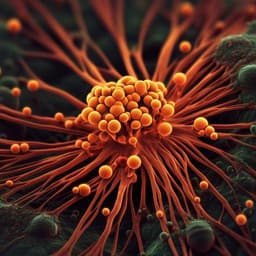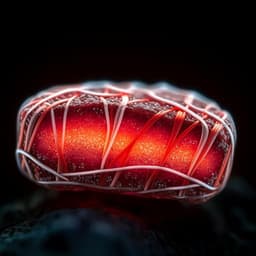
Food Science and Technology
High protein-containing new food by cell powder meat
B. Choi, S. Park, et al.
Explore the groundbreaking development of cell powder meat (CPM), a cost-effective and high-protein alternative to traditional meats, crafted without the need for a 3D scaffold. This innovative approach, explored by Bumgyu Choi and colleagues, promises to revolutionize cell-based meat production by delivering superior taste and nutrition at a lower cost.
~3 min • Beginner • English
Introduction
The study addresses the need for sustainable, high-quality alternative proteins to mitigate environmental impacts, resource constraints, and animal welfare issues associated with conventional livestock. While plant-, microbe-, microalgae-, and insect-based proteins are advancing, consumer perception and sensory drawbacks limit their adoption. Cell-based meat offers a promising route, but commercialization is hindered by costs (notably FBS in media), scalability, regulatory hurdles, and scaffold requirements. The authors propose fabricating a scaffold-free cell powder meat (CPM) with high protein content and meat-like flavor using reduced-serum media to lower costs. The research question is whether CPM can be produced cost-effectively without 3D scaffolds while achieving high protein content and desirable flavor, and whether low-serum growth conditions can enhance subsequent myogenic differentiation to increase protein yield.
Literature Review
Prior work on cultured meat emphasizes scaling and cost reduction through scaffold development and optimized media (e.g., gelatin-based spacers, chitosan/cellulose nanofilms delivering C-phycocyanin) and scaffold-free cell sheet approaches. Scaffolds for food must use food-grade materials and be low-cost, facing regulatory approval challenges. Food powders are valued for stability, preservation, and processing ease, yet plant/insect powders face sensory and acceptance limitations. Serum use is known to promote myoblast proliferation, while serum withdrawal promotes differentiation, implicating media composition and timing in myogenesis efficiency. These insights motivate a scaffold-free, powder-based cultured meat product using reduced-serum conditions to improve cost-efficiency and potential consumer acceptance.
Methodology
Cell line and culture: Mouse C2C12 myoblasts (ATCC, passages 8–13) were seeded at 2×10^3 cells/cm^2 and cultured at 37 °C, 5% CO2. Three growth media (GM) conditions were tested: G1 (DMEM + 10% FBS + 1% penicillin/streptomycin), G2 (DMEM + 5% FBS + 1% PS), G3 (DMEM + 5% FBS + 50 µg/mL C-phycocyanin + 1% PS). Cells were grown for 7 days with GM replaced every 2 days. At confluence (day 7), differentiation medium (DM) containing 5% horse serum + 1% PS replaced GM, and cells were differentiated for 5 days (DM changed every 2 days).
CPM preparation: After 12 total culture days, DM was removed, cells were PBS-washed, detached with a scraper, collected in distilled water, centrifuged at 300×g for 2 min, supernatant removed, pre-frozen at −20 °C for 12 h, then lyophilized 24 h to yield CPM.
Cell proliferation assay: C2C12 cells were seeded (2×10^3 cells/cm^2) in 12-well plates under G1–G3 and cultured 2, 4, 7 days; viability/proliferation measured by CCK-8 (OD at 450 nm).
Immunofluorescence and fusion index: After 5 days in DM, cells were fixed, blocked (BSA, Triton X-100, horse serum), stained with anti-MyHC (MF20) and Alexa Fluor 594 secondary, nuclei counterstained with DAPI. Confocal microscopy (Zeiss LSM 880, 10× objective) captured ≥3 random fields/sample. Fusion index was calculated as nuclei in myotubes (≥2 nuclei) divided by total nuclei ×100.
Protein quantification: Prior to powdering and for powders and reference meats (chicken breast, beef tenderloin), proteins were extracted using RIPA buffer; concentrations were quantified by BCA assay.
Flavor analysis: CPM and lyophilized beef were grilled at 120 °C with a little oil for 15 min. Volatiles were analyzed by HS-SPME GC-MS (Agilent 8890 GC–5977B MSD) on HP-5ms column (30 m×250 µm×0.25 µm). Oven: 40 °C 5 min; ramp 4 °C/min to 160 °C; 7 °C/min to 250 °C; hold 10 min. MS source 230 °C. Compounds identified via spectral library; flavor notes referenced from FEMA and JECFA.
Proteomics and GO analysis: Proteins from CPM and bovine tissue were processed via S-Trap, alkylated (20 mM iodoacetamide), acidified, washed (9:1 methanol:50 mM TEAB), digested with trypsin (10:1 w/w protein:enzyme), and analyzed by LC-MS/MS (KBSI). Differentially expressed proteins were defined as >2-fold intensity difference. GO enrichment (BP, MF, CC) was analyzed with DAVID (p<0.05).
Cost-efficiency evaluation: Media volumes per 90-mm dish were tallied: 24 mL GM (three 8 mL changes) + 16 mL DM (two 8 mL changes) = 40 mL total. Cost-efficiency was calculated as protein concentration (BCA) divided by total media cost for each group (values summarized relative to G1).
Statistics: Two-sample t-tests were used; p<0.05 (*) and p<0.01 (**) considered significant. Experiments conducted independently with data reported as mean ± SD (n=3 where stated).
Key Findings
- Proliferation: Across 2–7 days, proliferation (CCK-8 OD450) was similar among groups; G1 (10% FBS) showed slightly higher early proliferation but differences were not statistically significant.
- Differentiation: After 5 days in DM, myotube formation (MyHC staining) and fusion index were markedly higher in low-serum growth groups: G2 = 55.6% and G3 = 58.8% versus G1 = 21.9%.
- Protein yield/concentration: Higher differentiation correlated with higher protein levels (BCA). Protein concentrations of CPM preparations: G3 = 1.3 µg/µL, G2 = 1.0 µg/µL, G1 = 0.73 µg/µL.
- Cost-efficiency: Although G3 had highest protein concentration, media costs ranked G2 < G1 < G3. Cost-efficiency (protein per media cost) was G2 = 1.76, G1 = 1.00, G3 = 0.31, indicating a 76% improvement for G2 over G1.
- Yield per dish: From a 90-mm dish, average CPM mass was ~1.6 mg, containing ~749.5 µg protein (G2).
- Nutritional content: CPM exhibited a high protein content of 48.1%, surpassing chicken breast (25.7%) and beef tenderloin (20.7%).
- Flavor volatiles: CPM and beef both contained pentanal (almond note) and hexanal (oily/fatty). CPM uniquely showed acetic acid (fruity/sour) and heptanal (fatty/nutty), while beef had 2-methylbutyl acetate (fruity) and 3-methylbutanal (fatty/almond), supporting meat-like savory characteristics upon grilling.
- Proteomics: A total of 3,047 proteins were identified in CPM; 1,050 were upregulated and 491 downregulated relative to bovine muscle tissue (>2-fold threshold). Upregulated GO terms included RNA splicing, translation, protein folding (BP), RNA/protein binding (MF), and nucleus, cytoplasm, membrane, ribosome (CC). Downregulated terms included mitochondrial respiratory chain complex I assembly, muscle contraction, sarcomere organization (BP), protein/metal ion binding (MF), and mitochondria, Z discs, sarcomeres (CC).
- Process advantage: CPM was produced without 3D scaffolds and using reduced-serum media, enabling 76% higher cost-efficiency compared to conventional higher-serum medium (G1 baseline).
Discussion
The findings demonstrate that lowering serum during the growth phase enhances subsequent myogenic differentiation in the differentiation phase, leading to increased protein production per culture input. This addresses a core commercialization barrier for cultured meat—media cost—by showing that a reduced-serum growth medium (G2, 5% FBS) yields superior cost-efficiency while maintaining adequate proliferation and significantly improving differentiation. The scaffold-free CPM format further simplifies production, avoiding regulatory and cost challenges associated with food-grade scaffolds. Nutritional analysis positions CPM as a high-protein product outperforming conventional meats, while GC-MS volatile profiles indicate overlapping savory compounds with beef, supporting sensory relevance upon cooking. Proteomic comparisons clarify that CPM reflects cellular/myotube-level biology rather than organized muscle tissue, aligning with the powder product’s intended use while explaining differences in structural protein representation. Overall, CPM offers a practical, scalable route to cultured meat ingredients and seasonings with favorable protein density and cost metrics.
Conclusion
This work introduces cell powder meat (CPM) as a scaffold-free, high-protein cultured meat ingredient produced under reduced-serum conditions. Key contributions include: (1) demonstrating that low-serum growth enhances later differentiation and protein output; (2) achieving 76% higher cost-efficiency versus conventional higher-serum medium; (3) delivering high protein content (≈48%) and meat-like flavor volatiles; and (4) mapping proteomic profiles consistent with myoblast/myotube composition. CPM has potential as a base for diverse food applications and as a platform for scaling and cost reduction in cultured meat production. Future research may incorporate additional cell types (adipocytes, vascular cells, fibroblasts, osteoblasts) and species (cattle, pigs, chickens) to tailor nutrition and flavor, and develop processes to scale yields and refine sensory attributes.
Limitations
CPM reflects cellular/myotube-level organization rather than fully structured muscle tissue, as indicated by downregulation of sarcomere- and mitochondria-associated proteins relative to beef. The study focuses on a mouse myoblast cell line (C2C12) and analytical flavor profiling without comprehensive human sensory evaluation detailed. Yield per 90-mm dish is low, indicating the need for process scale-up for practical production.
Related Publications
Explore these studies to deepen your understanding of the subject.







